初中英语语法之 一般现在时
初中英语语法一般现在时

Yes, they do. No, they don’t.
She waters the flowers.
否定句:
She does not (doesn’t) water the flowers.
一般疑问句: 肯定回答: 否定回答:
Does she water the flowers? Yes, she does. No, she does not (doesn’t).
主语是第三人称单数时,行为动词的gets, swims, knows, plays等.
以s, x, ch, sh, 或o结尾的动词在词尾加-es,如 dresses, washes, catches, does等.
以辅音字母+y结尾的动词, 先变y为i,再加-es, 如 fly---flies, study--- studies等.
He is an office worker. I get up at six every day . 主语(第三人称单数)+动词s/es +其它成分. My father usually goes to work by bus.
否定句:
主语+am/is/are not+其它成分. 主语(除第三人称单数) +don’t+动词原形+其它 成分. They are not in the library. I don’t like swimming. 主语(第三人称单数)+doesn’t+动词原形+其它 成分. The old man doesn’t like playing cards .
改句子:
1. Do you often play football after school? (肯定回答)
Yes, I do. I often play football after school.
初中一般现在时【讲解+练习】

一般现在时的用法一、概述一般现在时表示习惯性、经常性、反复性的动作或存有的状态。
“习惯性、经常性、反复性”是一般现在时的三大特性,它不表示特定时间内发生的事。
二、一般现在时的结构时态的结构指的是动词的变化形式。
一般现在时间有两种结构,一种是动词原形,用于主语为非第三人称时的情况;另一种为动词的第三人称单数形式,用于主语为第三人称时的情况。
Eg1.We often get up early in the morning.Eg2.My father often gets up early in the morning.三、谈谈“主语为三单,其后动词s添”在一般现在时中,当主语为第三人称单数时,谓语动词要用第三人称单数形式。
能够简单叙述为“主语为三单,其后动词s添”。
何谓第三人称单数?用一句话概括就是“非你、非我、非复数”,如he, she, it, my father, my mother, my sister, our English teacher, Tom, Mike, Liu Jia, China, my book, etc.Eg3.He sometimes goes to school by bike.Eg4.My father works in the hospital as a doctor.四、动词第三人称单数变化规则动词第三人称变化的规则与可数名词复数变化的规则相同。
规则一、一般在词尾加-s。
如:looks, puts. reads, sees, skis等。
规则二、以-o, -s, -x, -sh, -ch结尾的加-es。
如:goes, does, misses, passes, mixes, fixes, pushes, wishes, watches, teaches,等。
规则三、以辅音字母加y结尾的,变y为i,再加-es。
注意一定是辅音字母加y才变,若是元音字母加y,则直接加-s。
初中英语语法——一般现在时知识点总结归纳资料讲解
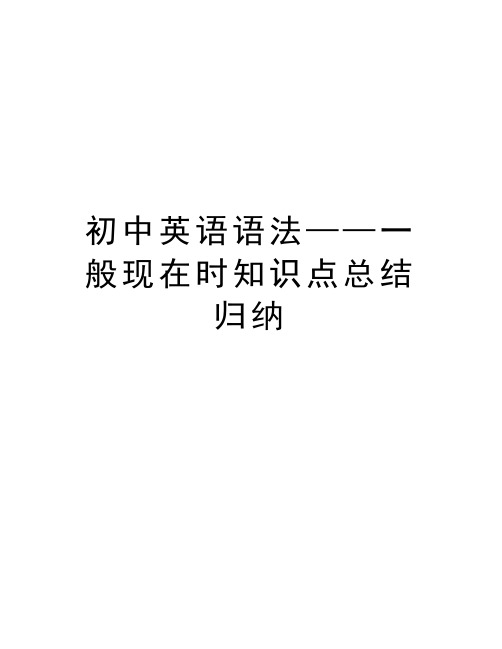
初中英语语法——一般现在时知识点总结归纳初中英语语法——一般现在时知识点总结归纳一般现在时——表示一般性,经常性的动作或一般性事实。
概念:表示经常发生的动作或经常存在的状态。
常和 always , often , usually , sometimes , every day 等表时间的状语连用。
如:1) I go to school every day . 我每天都去学校。
(表经常)2) He is always like that . 他总是那样。
(表状态)构成:1) 主语 + be (am / are / is ) +……2) 主语 + 实义动词/三单动词+ …【解析】1、含有be动词的句子He is a teacher.The girl is very beautiful.Tim and Jack are students.★变疑问句将be动词移到句首Is he a teacher?Is the girl very beautiful?Are Tim and Jack students?★变否定句在be动词后面加notHe is not a teacher.The girl is not very beautiful.Tim and Jack are not students.★肯定回答及否定回答Yes, he is. / No, he is not.Yes, she is. / No, she is not.Yes, they are. / No, they are not.2、不含有be动词的句子,即含有一般动词的句子。
(1)第三人称单数及单数名词He likes books.She likes him.The dog likes bones.★变疑问句在句首加does, 动词变为原型Does he like books?Does she like him?Does the dog like bones?★变否定句在主语及动词之间加doesn't, 动词变为原型,原句中的动词不再有第三人称变化。
一般现在时的知识点归纳七年级

一般现在时的知识点归纳七年级七年级英语教学中,一般现在时是最重要的语法点之一。
通过良好的教学方法和个性化的教学方式,学生们可以轻松掌握这一知识点。
在本文中,我们将对一般现在时进行深入剖析,来帮助学生更好地掌握这一知识点。
一、一般现在时的定义一般现在时指的是现在正在发生或经常发生的动作或状态。
它的时态形式为:主语(第三人称单数要加s或es) + 动词原形。
例如:He plays basketball.(他打篮球。
)二、一般现在时的用法1. 表述客观事实:比如地理事实、自然现象、名人事实等。
例如:The sun rises in the east.(太阳从东方升起。
)2.表述经常性动作或状态:比如习惯性的动作、日常行为、反复发生的动作等。
例如:I usually go to bed at 10 p.m.(我通常在晚上10点钟睡觉。
)3.表述真理或普遍事实:比如科学定理、社会现象、人定律等。
例如:Water freezes at 0 degrees Celsius.(水在零度时结冰。
)4. 表示主语所具备的特征等性质。
例如:She is kind and friendly.(她友善又和蔼。
)三、一般现在时的标志词一般现在时没有专门的标志词,但在使用中,我们通常可以根据上下文来判断。
四、一般现在时的否定句和疑问句1.否定句:在be动词后加not,其他动词在前面加助动词do/does,其后紧随not。
例如:He does not run fast.(他跑得不快。
)2. 疑问句:将助动词do/does提前到主语前,其他句子成分不变。
例如: Do you like playing basketball?(你喜欢打篮球吗?)五、常见的时间状语时间状语指的是句子中表示时间的词或短语。
以下是常见的时间状语:1. every day (每天)2. every week (每周)3. every month (每月)4. every year (每年)5. on Monday (在星期一)6. in the morning (在早晨)7. at night (在晚上)8. at the weekend (在周末)六、一般现在时常见错误1. 第三人称单数动词形式错误:在第三人称单数主语后要加s/es。
初中英语语法——一般现在时讲解

初中英语时态——一般现在时讲解一般现在时主要用法1.表示经常性、习惯性的动作或者状态标志性词:every、always、usually、often、sometimes、seldom、never I get up at 7 every day.我每天7点起床。
That girl usually walks to school.那个女孩通常步行上学。
2.表示科学真理、有规律的自然现象Light travels faster than sound.光速比声速快。
The sun rises in the east.太阳从东方升起。
3.表示目前的状态、喜好等I am a student.我是一名学生。
My father likes reading books.我父亲喜欢读书。
4.if条件状语从句和when时间状语从句:主将从现He will go to the park if it is sunny tomorrow.如果明天天气晴朗,他将去公园。
区别:I wonder if it will be sunny tomorrow.我想知道明天天气是否晴朗。
一般现在时句型结构1.谓语是be动词(am/is/are)①肯定句:主语+be动词+其他.I am fifteen years old.You are a clever boy.She is an English teacher.②否定句:主语+be动词+not+其他.I am not fifteen years old.You are not a clever boy.She is not an English teacher.③一般疑问句:Be动词+主语+其他?肯定回答:Yes,主语+be动词.否定回答:No, 主语+ be动词+not.—Are you fifteen years old?—Yes,I am./No,I'm not.—Is she an English teacher?—Yes, she is./No, she isn't.④特殊疑问句:特殊疑问词+be动词+主语+其他? Where are they?2.谓语动词是实义动词主语是第一人称、第二人称、第三人称复数:①肯定句:主语+动词原形+其他.I have a lot of interesting books.You look nice in the dress.They go shopping every weekend.②否定句:主语+don't+动词原形+其他.I don't have a lot of interesting books.You don't look nice in the dress.They don't go shopping every weekend.③一般疑问句:Do+主语+动词原形?肯定回答:Yes,主语+do.否定回答:No, 主语+ don't.—Do you have a lot of interesting books?—Yes, I do./ No, I don't.④特殊疑问句:特殊疑问词+do+主语+动词原形+其他? When do you go to school?What do they like?主语是第三人称单数:①肯定句:主语+动词第三人称单数+其他.He has a short black hair.Helen likes juice.②否定句:主语+doesn't+动词原形+其他.He doesn't have short black hair.Helen doesn't like juice.③一般疑问句:Does+主语+动词原形+其他?肯定回答:Yes,主语+does.否定回答:No, 主语+doesn't.—Does he have short black hair?—Yes, he does./No, he doesn't.④特殊疑问句:特殊疑问词+does+主语+动词原形+其他? Which subject does your sister like best?Where does he often go after school?3. 谓语是情态动词①肯定句:主语+情态动词+动词原形+其他.I can draw beautiful pictures.He can speak English well.They can borrow some magazines from the library.②否定句:主语+情态动词+not+动词原形+其他.I can't draw beautiful pictures.He can't speak English well.They can't borrow some magazines from the library.③一般疑问句:情态动词Can+主语+动词原形?肯定回答:Yes,主语+情态动词.否定回答:No, 主语+ 情态动词+not.—Can you play volleyball?—Yes,I can./No, I can't.④特殊疑问句:特殊疑问词+情态动词+主语+动词原形+其他?回答:主语+情态动词+动词原形+其他.—What can you do?—I can play the piano.第三人称单数一、人称代词he, she, it是第三人称单数。
一般现在时语法知识点总结

一般现在时语法知识点总结一、一般现在时的概念。
一般现在时表示经常的、习惯性的动作或存在的状态。
例如:I often get up at six o'clock.(我经常在六点钟起床。
)The earth goes around the sun.(地球绕着太阳转。
)二、一般现在时的构成。
1. be动词的一般现在时形式。
- 主语为第一人称单数(I)时,be动词用am。
例如:I am a student.- 主语为第三人称单数(he/she/it等)时,be动词用is。
例如:He is a doctor.- 主语为第二人称单数(you)、第一人称复数(we)、第二人称复数(you)、第三人称复数(they)时,be动词用are。
例如:You are my friends. They are workers.2. 实义动词(行为动词)的一般现在时形式。
- 当主语为第三人称单数(he/she/it,单个的人名、地名或单数可数名词等)时,实义动词一般在词尾加 -s或 -es。
- 一般情况下加 -s,如:play - plays,like - likes。
- 以s,x,ch,sh,o结尾的动词加 -es,如:go - goes,watch - watches。
- 以辅音字母 + y结尾的动词,把y变为i再加 -es,如:study - studies。
- 当主语为第一人称单数(I)、第二人称单数(you)、第一人称复数(we)、第二人称复数(you)、第三人称复数(they)时,实义动词用原形。
例如:I like reading. They play football every day.三、一般现在时的用法。
1. 表示经常或习惯性的动作。
- 常与表示频率的副词或短语连用,如:always(总是),usually(通常),often(经常),sometimes(有时),seldom(很少),never(从不),every day (每天),once a week(每周一次)等。
初中一般现在时讲解
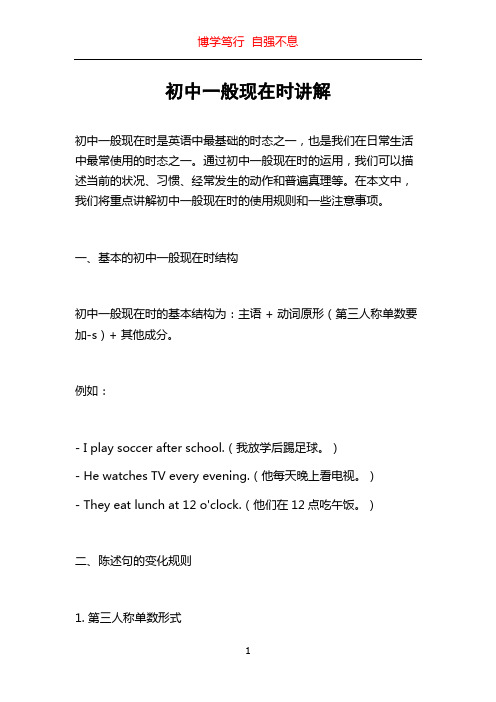
初中一般现在时讲解初中一般现在时是英语中最基础的时态之一,也是我们在日常生活中最常使用的时态之一。
通过初中一般现在时的运用,我们可以描述当前的状况、习惯、经常发生的动作和普遍真理等。
在本文中,我们将重点讲解初中一般现在时的使用规则和一些注意事项。
一、基本的初中一般现在时结构初中一般现在时的基本结构为:主语 + 动词原形(第三人称单数要加-s)+ 其他成分。
例如:- I play soccer after school.(我放学后踢足球。
)- He watches TV every evening.(他每天晚上看电视。
)- They eat lunch at 12 o'clock.(他们在12点吃午饭。
)二、陈述句的变化规则1. 第三人称单数形式在初中一般现在时中,第三人称单数(he、she、it或名词单数)的动词要变为原形加上-s。
例如:- She sings very well.(她唱得很好。
)- He plays basketball with his friends.(他和他的朋友们一起打篮球。
)- The dog barks loudly at strangers.(这条狗对陌生人叫得很大声。
)2. 不可数名词和复数名词与不可数名词一起使用时,动词保持原形。
与复数名词一起使用时,动词也保持原形。
例如:- The water tastes good.(水的味道很好。
)- The boys play soccer every Saturday.(这些男孩每个星期六踢足球。
)3. 特殊的第三人称单数形式以s、x、ch、sh和o结尾的名词通常在第三人称单数形式中加-es。
例如:- The bus goes to the city center.(这辆公交车开往市中心。
)- A box of candies is on the table.(桌子上有一盒糖果。
)- She brushes her teeth after meals.(她餐后刷牙。
初中英语一般现在时知识点

初中英语一般现在时知识点一般现在时是指在现在发生或存在的动作、状态和习惯。
以下是一般现在时的知识点:1. 形式:一般现在时的形式为主语 + 动词原形(或第三人称单数形式)、主语 + be动词原形(am, is, are)+ 动词-ing形式。
2. 第三人称单数形式:当主语是第三人称单数(he, she, it)时,动词要加 -s或 -es。
例如:She likes to play the piano.3. be动词的使用:be动词表示临时状态、习惯性状态和现有派生动词的被动语态。
例如:I am a student. They are playing soccer. The book is being read.4. 动词的形式变化:有些动词在一般现在时态中有特殊的形式变化。
例如:go -> goes, do -> does, have -> has。
5. 可数名词和不可数名词:可数名词使用单数形式,不可数名词使用单数或不变形式。
例如:She has two cats. I have a lot of water.7. 表示真理、自然现象和客观事实:一般现在时也可以用来表示真理、自然现象和客观事实。
例如:The sun rises in the east. Water boils at 100 degrees Celsius.8. 表示未来时间:一般现在时有时也可以用来表示未来安排或时间表中的事件。
例如:The train leaves at 6 o'clock tomorrow.9. 否定句和疑问句:一般现在时的否定句结构为主语 + donot/does not + 动词原形。
疑问句结构为Do/Does + 主语 + 动词原形。
以上是一般现在时的主要知识点,通过学习和掌握这些知识点,你就能正确运用一般现在时来描述现在的动作、状态和习惯。
初中英语语法知识之一般现在时
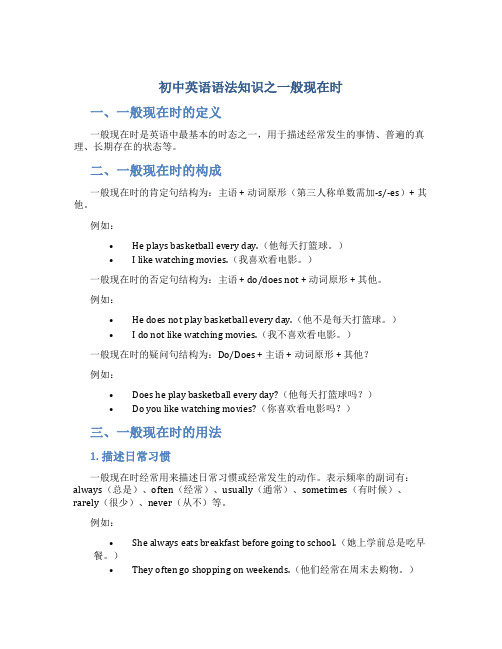
初中英语语法知识之一般现在时一、一般现在时的定义一般现在时是英语中最基本的时态之一,用于描述经常发生的事情、普遍的真理、长期存在的状态等。
二、一般现在时的构成一般现在时的肯定句结构为:主语 + 动词原形(第三人称单数需加-s/-es)+ 其他。
例如:•He plays basketball every day.(他每天打篮球。
)•I like watching movies.(我喜欢看电影。
)一般现在时的否定句结构为:主语 + do/does not + 动词原形 + 其他。
例如:•He does not play basketball every day.(他不是每天打篮球。
)•I do not like watching movies.(我不喜欢看电影。
)一般现在时的疑问句结构为:Do/Does + 主语 + 动词原形 + 其他?例如:•Does he play basketball every day?(他每天打篮球吗?)•Do you like watching movies?(你喜欢看电影吗?)三、一般现在时的用法1. 描述日常习惯一般现在时经常用来描述日常习惯或经常发生的动作。
表示频率的副词有:always(总是)、often(经常)、usually(通常)、sometimes(有时候)、rarely(很少)、never(从不)等。
例如:•She always eats breakfast before going to school.(她上学前总是吃早餐。
)•They often go shopping on weekends.(他们经常在周末去购物。
)2. 表达客观事实或普遍真理一般现在时也被用来表达客观事实或普遍真理。
例如:•The Earth revolves around the sun.(地球绕太阳运行。
)•Water boils at 100 degrees Celsius.(水在100摄氏度沸腾。
初中英语语法总结一般现在时
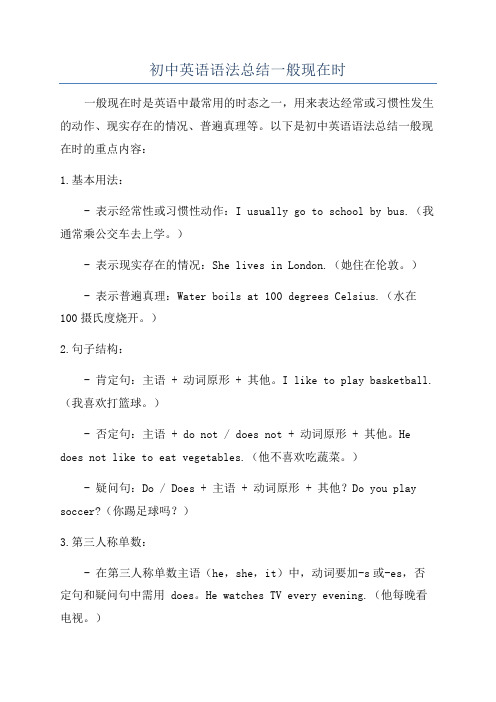
初中英语语法总结一般现在时一般现在时是英语中最常用的时态之一,用来表达经常或习惯性发生的动作、现实存在的情况、普遍真理等。
以下是初中英语语法总结一般现在时的重点内容:1.基本用法:- 表示经常性或习惯性动作:I usually go to school by bus.(我通常乘公交车去上学。
)- 表示现实存在的情况:She lives in London.(她住在伦敦。
)- 表示普遍真理:Water boils at 100 degrees Celsius.(水在100摄氏度烧开。
)2.句子结构:- 肯定句:主语 + 动词原形 + 其他。
I like to play basketball.(我喜欢打篮球。
)- 否定句:主语 + do not / does not + 动词原形 + 其他。
He does not like to eat vegetables.(他不喜欢吃蔬菜。
)- 疑问句:Do / Does + 主语 + 动词原形 + 其他?Do you play soccer?(你踢足球吗?)3.第三人称单数:- 在第三人称单数主语(he,she,it)中,动词要加-s或-es,否定句和疑问句中需用 does。
He watches TV every evening.(他每晚看电视。
)- 一些以s, sh, ch, x, o结尾的单词,需要在动词后加-es,如:misses,washes,watches。
4.频率副词:- 频率副词通常放在动词之前,用于修饰动词。
例如:She always helps others.(她总是帮助别人。
)5.现在进行时与一般现在时的区别:- 现在进行时表示现在正在发生的动作,一般与现在时间状语连用,或表示现阶段的临时情况。
例如:I am studying for the exam.(我正在准备考试。
- 一般现在时表示经常性、习惯性的动作或客观存在的状态。
例如:I usually play soccer on weekends.(我通常在周末踢足球。
初中英语知识点总结一般现在时
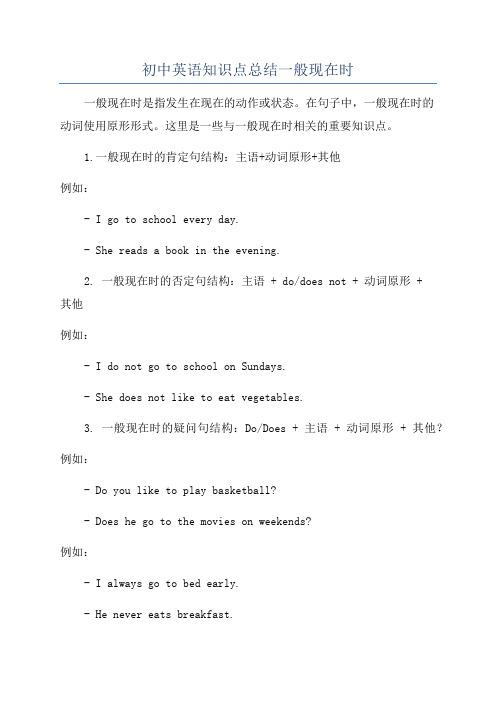
初中英语知识点总结一般现在时一般现在时是指发生在现在的动作或状态。
在句子中,一般现在时的动词使用原形形式。
这里是一些与一般现在时相关的重要知识点。
1.一般现在时的肯定句结构:主语+动词原形+其他例如:- I go to school every day.- She reads a book in the evening.2. 一般现在时的否定句结构:主语 + do/does not + 动词原形 +其他例如:- I do not go to school on Sundays.- She does not like to eat vegetables.3. 一般现在时的疑问句结构:Do/Does + 主语 + 动词原形 + 其他?例如:- Do you like to play basketball?- Does he go to the movies on weekends?例如:- I always go to bed early.- He never eats breakfast.5. 表示客观真理、规律或常识时,一般现在时可用于所有人称,不需要使用助动词do/does。
例如:- The sun rises in the east.- Water boils at 100 degrees Celsius.6. 当主语为第三人称单数时,动词需要变化。
一般情况下,加上-s 或-es。
例如:- She eats lunch at 12 o'clock.- The dog barks loudly.7.部分动词在第三人称单数时需要做变化- go→goes- do→does- have→has例如:- He goes to school by bus.- She does her homework every day.- My mother has a pet cat.8. 当主语为we, they, you或复数名词时,动词不需要做变化。
初中英语语法知识之一般现在时

初中英语语法知识之一般现在时有很多同学分不清时态,时态是一篇文章的主线,如果时态都分不清那我们就分不清事情发生的先后,会对我们做题设障碍,所以今天小编为大家整理了一些时态上的知识,希望能帮到大家。
一般现在时表示现在经常反复发生的动作、存在的状态或习惯性的动作的时态。
一、一般现在时用法如下:1.表示现在的状态: e.g. He’s twelve. She’s at work.2.表经常或习惯性的动作,常与表示频度的时间状语连用。
: eg. I get up at 6:30 every day.He reads English every morning.3.表主语具备的性格、能力和特征。
e.g. I don't like this book.4.表示客观事实和普遍真理。
The earth moves around the sun.5. 在时间状语从句和条件状语从句中,常用一般现在时代替将来时。
eg. I'll write to you as soon as I arrive there.二、一般现在时构成:一般现在时用行为动词的原形,但第三人称单数作主语时,动词要用第三人称单数形式。
第三人称单数形式的变化规则是:1.一般的动词词尾+S。
2.以sh/ch/s/x 结尾的词+es.3.以辅音字母+Y 结尾的把 Y 变成 i,+es。
4.辅音字母+o 结尾的+es.基本结构:1.be 动词肯定句:主语+be(am,is,are)+其它。
如: I am a boy.我是一个男孩。
否定句:主语+ be + not +其它。
如:He is not a worker.他不是工人。
一般疑问句:Be +主语+其它。
如:-Are you a student? -Yes. I am. / No, I'm not.特殊疑问句:疑问词+一般疑问句。
如:Where is my bike?2.行为动词1) 当主语为第一,二人称及复数时,助动词为 do肯定句:主语+动词原形(+其它)。
初中英语一般现在时的知识点归纳
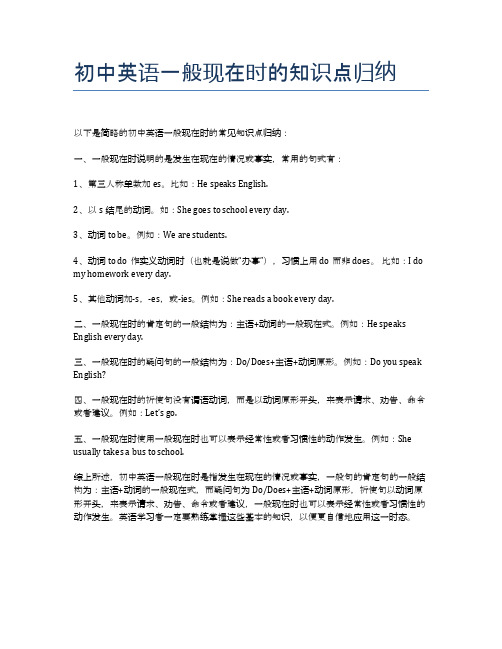
初中英语一般现在时的知识点归纳以下是简略的初中英语一般现在时的常见知识点归纳:一、一般现在时说明的是发生在现在的情况或事实,常用的句式有:1、第三人称单数加es。
比如:He speaks English.2、以s结尾的动词。
如:She goes to school every day.3、动词to be。
例如:We are students.4、动词to do作实义动词时(也就是说做“办事”),习惯上用do而非does。
比如:I do my homework every day.5、其他动词加-s,-es,或-ies。
例如:She reads a book every day.二、一般现在时的肯定句的一般结构为:主语+动词的一般现在式。
例如:He speaks English every day.三、一般现在时的疑问句的一般结构为:Do/Does+主语+动词原形。
例如:Do you speak English?四、一般现在时的祈使句没有谓语动词,而是以动词原形开头,来表示请求、劝告、命令或者建议。
例如:Let’s go.五、一般现在时使用一般现在时也可以表示经常性或者习惯性的动作发生。
例如:She usually takes a bus to school.综上所述,初中英语一般现在时是指发生在现在的情况或事实,一般句的肯定句的一般结构为:主语+动词的一般现在式,而疑问句为Do/Does+主语+动词原形,祈使句以动词原形开头,来表示请求、劝告、命令或者建议,一般现在时也可以表示经常性或者习惯性的动作发生。
英语学习者一定要熟练掌握这些基本的知识,以便更自信地应用这一时态。
初中英语语法:一般现在时、一般过去时和一般将来时
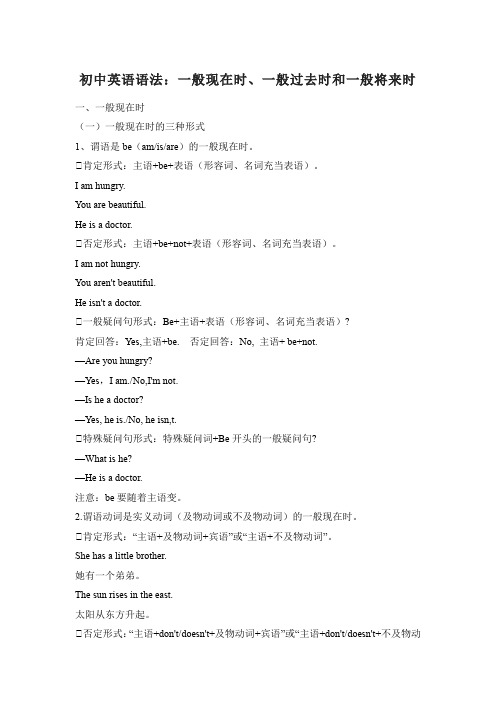
初中英语语法:一般现在时、一般过去时和一般将来时一、一般现在时(一)一般现在时的三种形式1、谓语是be(am/is/are)的一般现在时。
①肯定形式:主语+be+表语(形容词、名词充当表语)。
I am hungry.You are beautiful.He is a doctor.①否定形式:主语+be+not+表语(形容词、名词充当表语)。
I am not hungry.You aren't beautiful.He isn't a doctor.①一般疑问句形式:Be+主语+表语(形容词、名词充当表语)?肯定回答:Yes,主语+be. 否定回答:No, 主语+ be+not.—Are you hungry?—Yes,I am./No,I'm not.—Is he a doctor?—Yes, he is./No, he isn,t.①特殊疑问句形式:特殊疑问词+Be开头的一般疑问句?—What is he?—He is a doctor.注意:be要随着主语变。
2.谓语动词是实义动词(及物动词或不及物动词)的一般现在时。
①肯定形式:“主语+及物动词+宾语”或“主语+不及物动词”。
She has a little brother.她有一个弟弟。
The sun rises in the east.太阳从东方升起。
①否定形式:“主语+don't/doesn't+及物动词+宾语”或“主语+don't/doesn't+不及物动词”。
She doesn't have a little brother.她没有弟弟。
I don't eat every morning.我每天早晨都不吃饭。
①一般疑问句形式:“Do/Does+主语+及物动词原形+宾语”或“Do/Does+主语+不及物动词原形”。
肯定回答:Yes,主语+do/does. 否定回答是:No, 主语+ don't/doesn't.—Do you eat every morning?—Yes, I do./No, I don't.—Does she have a little brother?—Yes, she does./No, she doesn't.①特殊疑问句:特殊疑问词+do/does开头的一般疑问句?What do you like?When do you go to school?注意:根据主语确定用do还是does。
中考英语《一般现在时》知识点:一般现在时态
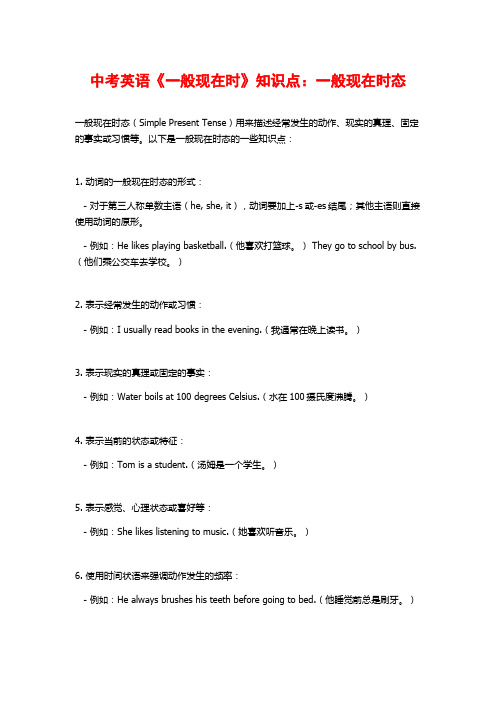
中考英语《一般现在时》知识点:一般现在时态一般现在时态(Simple Present Tense)用来描述经常发生的动作、现实的真理、固定的事实或习惯等。
以下是一般现在时态的一些知识点:1. 动词的一般现在时态的形式:- 对于第三人称单数主语(he, she, it),动词要加上-s或-es结尾;其他主语则直接使用动词的原形。
- 例如:He likes playing basketball.(他喜欢打篮球。
) They go to school by bus.(他们乘公交车去学校。
)2. 表示经常发生的动作或习惯:- 例如:I usually read books in the evening.(我通常在晚上读书。
)3. 表示现实的真理或固定的事实:- 例如:Water boils at 100 degrees Celsius.(水在100摄氏度沸腾。
)4. 表示当前的状态或特征:- 例如:Tom is a student.(汤姆是一个学生。
)5. 表示感觉、心理状态或喜好等:- 例如:She likes listening to music.(她喜欢听音乐。
)6. 使用时间状语来强调动作发生的频率:- 例如:He always brushes his teeth before going to bed.(他睡觉前总是刷牙。
)需要注意的是,一般现在时态还可以用来表示将来安排好的事情,但需要配合适当的时间状语来使用。
例如:We have a meeting tomorrow.(我们明天有一个会议。
)但在这种情况下,一般现在时态通常会与表示将来的时间短语一起使用,比如tomorrow(明天)、next week(下周)等。
初中英语语法之一般现在时运用及难点分析

初中英语语法之一般现在时运用及难点分析一般现在时的构成以及各种句式我们首先来看看一般现在时的构成。
一般现在时的构成:a. be动词过去式的句式。
否定句是在was/were后面加not,was not (wasn't)/were not (weren't)。
一般疑问句是把was / were提前并放到句首,要求首字母要大写。
b.实义动词过去式的句式。
①肯定式:主语+动词过去式+其它。
如:They had a good time yesterday.②否定式:主语+did not(didn't)+动词原形+其它。
如:They didn't watch TV last night.③一般疑问句:Did+主语+动词原形+其它?肯定回答:Yes,主语+did.否定回答:No,主语+didn't.如:Did they have a meeting two days ago? Yes,they did. / No,they didn't.④特殊疑问句:特殊疑问词+did+主语+动词原形+其它?如:What time did you finish your homework?一般现在时的句子转换(1)当句子中有be动词或情态动词时,则把be动词或情态动词(can,could等等)提到主语的前面变成疑问句;在be动词或情态动词后面加not变成否定句.例:①陈述句:She is a student.疑问句→ Is she a student?否定句→ She is not a student.②陈述句:I can swim.疑问句→ Can you swim .否定句→ I can not swim.(2) 当句子中即没有be动词,也没有情态动词时,则在主语前加助动词do (you,以及复数), does(单数she,he,it)变成问句;在主语后谓语动词前加助动词don’t(I,you,以及复数), doesn’t(单数she,he,it)变成否定句,助动词后的动词要变成动词原形。
一般现在时的语法公式
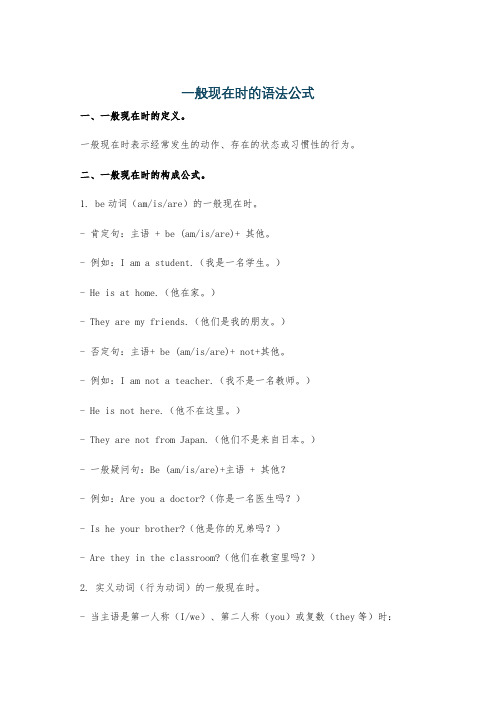
一般现在时的语法公式一、一般现在时的定义。
一般现在时表示经常发生的动作、存在的状态或习惯性的行为。
二、一般现在时的构成公式。
1. be动词(am/is/are)的一般现在时。
- 肯定句:主语 + be (am/is/are)+ 其他。
- 例如:I am a student.(我是一名学生。
)- He is at home.(他在家。
)- They are my friends.(他们是我的朋友。
)- 否定句:主语+ be (am/is/are)+ not+其他。
- 例如:I am not a teacher.(我不是一名教师。
)- He is not here.(他不在这里。
)- They are not from Japan.(他们不是来自日本。
)- 一般疑问句:Be (am/is/are)+主语 + 其他?- 例如:Are you a doctor?(你是一名医生吗?)- Is he your brother?(他是你的兄弟吗?)- Are they in the classroom?(他们在教室里吗?)2. 实义动词(行为动词)的一般现在时。
- 当主语是第一人称(I/we)、第二人称(you)或复数(they等)时:- 肯定句:主语+动词原形+其他。
- 例如:I like reading books.(我喜欢读书。
)- We play football on Sundays.(我们在星期天踢足球。
)- You go to school by bike.(你骑自行车去上学。
)- They have a lot of fun.(他们玩得很开心。
)- 否定句:主语+ don't+动词原形+其他。
- 例如:I don't like math.(我不喜欢数学。
)- We don't watch TV every day.(我们不是每天都看电视。
)- You don't know him.(你不认识他。
七年级英语重点语法:一般现在时

七年级英语重点语法:一般现在时1.一般现在时的用法①表示经常性、习惯性的动作或存在的状态。
常与频度副词连用。
I often take a walk in the park. 我经常在公园散步。
These T-shirts are new. 这些T恤衫是新的。
①表示客观事实、真理。
The sun rises in the east and sets in the west. 太阳东升西落。
①在时间、条件状语从句中表示将来的动作。
If it doesn’t rain tomorrow, I will go bike riding in the open air. 如果明天不下雨,我将在户外骑自行车。
I’ll tell her the good news when she comes back. 当她回来的时候,我将把这个好消息告诉她。
①表示按计划或安排将要发生的动作,可用一般现在时表将来。
但只限于start,begin,leave,go,come,arrive,return,take place等。
2.一般现在时的构成语法知识精练题型一:“三单”形式的变化规则1.—What happens when water freezes?—It ________ into ice.A.turns B.will turn C.turned D.has turned2.Tom ________ to school by bike every morning.A.go B.went C.is going D.goes3.The boy never ________ his teeth before bedtime. His parents are very angry.A.brush B.brushes C.brushed D.brushing4.The earth is a planet (行星) and it ________ around the sun.A.goes B.go C.will go D.went5.Mr. Green has two dogs. He ____________ them every morning.A.walked B.will walk C.walks D.is walking6.Amy usually ________ sports on Sunday mornings.A.is having B.has C.has had D.was having7.Tony usually ________ to school on time, but this morning he ________ late.A.gets; arrives B.got; arrived C.gets; arrived D.got; arrives8.She usually ________ to music in the evening, but now she ________ TV.A.listens; watches B.is listening; watchesC.listens; is watching D.is listening; is watching9.Mike usually _______ up at six thirty in the morning, but he _______ up at seven this morning. He was late for school.A.got; got B.got; gets C.gets; gets D.gets; got10.Linda _________ a twin brother, and she is _________ than him.A.is; taller B.has; tall C.has; taller D.have; taller11.It often _________ here in winter. Look! It’s _________ again.A.snows; snowing B.snowy; snowingC.snows; snows D.snowing; snows12._______ his sister, he also ________ running.A.Like; like B.Likes; likes C.Like; likes D.Likes; like13.Tommy always ________ to keep healthy. Look! He ________ in the pool now.A.swims; swims B.swims; is swimmingC.is swimming; is swimming D.is swimming; swims14.Bob ________ basketball and he looks ________ his father.A.likes, like B.like, likes C.likes, likes D.like, like15.—Does Ella like ________?—Yes. She often ________ things from the stores.A.shop; buys B.shop; is buyingC.shopping; buys D.shopping; is buying16.It often _________ heavily in summer. We have to wear raincoats when we go out.A.rains B.rain C.snows D.snow17.It often ______ in South China.A.snow B.snows C.rainy D.rains18.Jane sometimes ________ around the city with her parents on weekends.A.travel B.travelsC.traveled D.will travel19.When ice melts, it ________ into water.A.turns B.will turn C.turned D.is turning20.Mike ________ of medium height and he ________ short hair.A.is, is B.are, have C.has, has D.is, has题型二:表示经常性动作/状态21.I ______ basketball on the playground with my friends every Saturday.A.play B.will play C.played D.am playing22.Every year, the Vienna New Year’s Concert ________ place on 1st January.A.takes B.is taking C.took D.will take23.Tom usually ______ his bike to school but he ______ the subway there this morning.A.rides; took B.rides; takes C.ride; took D.rode; took24.Chinese people often ________ when they meet visitors.A.smile B.smiled C.are smiling D.will smile25.—Steve, what do you often do after school?—I often ________ basketball with my friends.A.play B.played C.will play D.am playing26.Susan lives far from school. She usually ________ a bus to school.A.has taken B.took C.takes D.will take27.—Listen! Someone ________ in the next room.—It must be Lily. She ________ singing every afternoon.A.sings; practices B.sings; practicing C.is singing; practices D.is singing; is practicing 28.—It ________ heavily last night. So there is snow on the ground everywhere today.—Yes. It often ________ here in winter.A.snowed; snows B.snowed; is snowing C.snows; is snowing D.snows; snows 29.Jim often ________ for a walk after dinner. But yesterday he ________.A.go; doesn’t B.goes; didn’t C.went; didn’t D.went; doesn’t 30.He often _________ French after _________ his homework every day.A.study; finish B.studied; finished C.studies; finishing D.studying; finishing题型三:表示现在的能力/特征31.—Does Alice like oranges?—No, she doesn’t. She ________ apples.A.like B.liking C.liked D.likes32.The store _______ T-shirts in all colors and they’re on _______.A.sell; sale B.sale; sell C.sells; sale D.sales; sell33.My brother _______ the piano very well, but he doesn’t have time to play now.A.will play B.is playing C.played D.plays34.Many years ago, I ________ to be a doctor. But now ________ a worker.A.wanted; I was B.wanted; I’mC.want; I’m D.want; I was35.My sister ________ walk a year ago, but now she ________.A.couldn’t; could B.couldn’t; can C.can; can D.could; could题型四:表示事实或客观真理36.—Where ________ he from?—He is from the United States.A.was B.are C.am D.is37.Allen used _________ to school, but now he _________ to school by bus.A.walking; goes B.walking; is going C.to walk; goes D.to walk; going 38.One of my friends ________ a pet dog. The dog’s name is Duoduo.A.have B.has C.to have D.having39.— We ________ very simply and do not spend much money on food.— That’s why you’re called the Greens.A.eat B.ate C.will eat D.had eaten40.— Look at the sign there! It ________ “No fishing!”— Sorry, I __________ notice it.A.said; don’t B.said; didn’t C.says; didn’t D.says; don’t 41.—Let’s buy some ________ for our school trip.—That ________ good.A.strawberry; sound B.salad; sounds C.hamburger; sounds D.pear; sound42.I ________ a red book. She ________ two red books.A.have; has B.has; have C.have; have D.has; has43.As we all know, light ________ a lot faster than sound.A.travels B.travelled C.is travelling D.to travel44.One of his best friends ________ the US.A.come from B.is from C.are from D.are coming from 45.His mother ________ in a hospital, but she ________ there these days.A.works; isn’t workingB.is working; worksC.is work; doesn’t workD.works; not works题型五:表示现在发生的具体动作46.—What club does he join?—He can _________ pictures, so he ________ the art club.A.draw; join B.draws; joins C.draws; join D.draw; joins 47.—Great news! The land (着陆) of The Shenzhou XIII is a great success!—It ________ me excited and ________ proud to be a Chinese.A.make; feel B.made; to feel C.makes; feel D.makes; feeling 48.I at the picture now. I some koalas in it.A.am looking; see B.look; seeingC.am looking; am seeing D.look; see49.—The phone is ringing, Sam.— I _______, but I’m busy. Could you answer it, please?A.know B.knowing C.am knowing D.knew 50.Mike _________ the earphones on the sofa a moment ago, but now they _________ there. A.put; weren’t B.put; aren’tC.putted; are D.puts; are参考答案:1.A【详解】句意:——当水冻结时会发生什么?——它会变成冰。
初中英语语法之一般现在时PPT课件

☺ 一般疑问句: Do+主语(非三单)+v.原形+其他? 肯定回答:Yes, 主语+do. 否定回答:No, 主语+don't. 1) _D_o_ you_s_t_a_y (stay) at home on Saturdays? 2) _D_o_ theyh_a_v_e_(have) sports every day? ☺Does+主语(三单)+v.原形+其他?
如果你接受这份工作,他们将和你谈谈细
15
6、表示格言或警句。 例如:Pride goes before a fall. 骄者必败。 注意:此用法如果出现在宾语从句中, 即使主句是过去时,从句谓语也要用 一般现在时。
16
一般现在时表达方法
主要通过谓语动词的变化和用时间词语来 表示,其中最主要的是谓语动词的变化。 一般现在时动词变化的规则是: 当主语为非第三人称单数,谓语动词用原型。 当主语为第三人称单数,谓语动词用第三人 称单数形式。e.g. 1. We often get up early in the morning. 2. My father often gets up early in the
13
4.普遍真理和自然规律: 1) Two and four is six.
二加四等于六。 2)The moon goes around the earth. 月亮绕着地球转。 3)Ten minus two is eight.十减二 等于八。 4)Light travels faster than sound . 光的速度比声音的速度快。
21
4.以辅音字母+o结尾的词,一般情况是在 词尾加es, 读作[z]
初中英语语法一般现在时全解
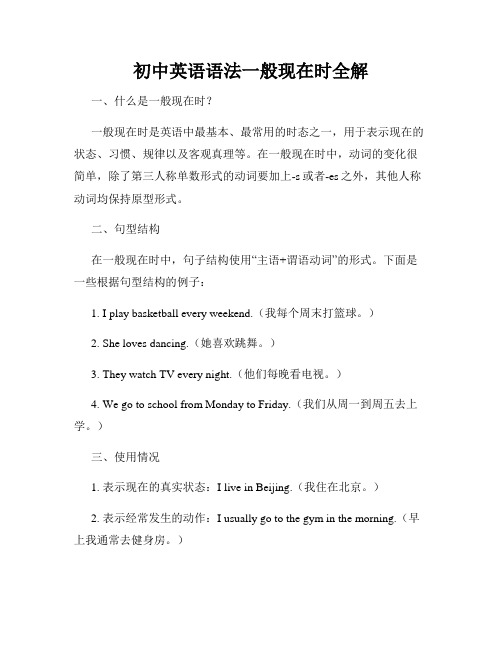
初中英语语法一般现在时全解一、什么是一般现在时?一般现在时是英语中最基本、最常用的时态之一,用于表示现在的状态、习惯、规律以及客观真理等。
在一般现在时中,动词的变化很简单,除了第三人称单数形式的动词要加上-s或者-es之外,其他人称动词均保持原型形式。
二、句型结构在一般现在时中,句子结构使用“主语+谓语动词”的形式。
下面是一些根据句型结构的例子:1. I play basketball every weekend.(我每个周末打篮球。
)2. She loves dancing.(她喜欢跳舞。
)3. They watch TV every night.(他们每晚看电视。
)4. We go to school from Monday to Friday.(我们从周一到周五去上学。
)三、使用情况1. 表示现在的真实状态:I live in Beijing.(我住在北京。
)2. 表示经常发生的动作:I usually go to the gym in the morning.(早上我通常去健身房。
)3. 表示普遍真理或客观规律:The sun rises in the east.(太阳从东方升起。
)4. 表示评论、陈述、想法等:I think English is an interesting subject.(我认为英语是个有趣的科目。
)四、一般现在时的注意事项1. 第三人称单数形式的动词要加上-s或者-es:He reads books every day.(他每天阅读书籍。
)但是要注意规则动词的变化,如do变为does。
2. 否定句需要在谓语动词前加上助动词do或does,并在其后加上not:I do not like coffee.(我不喜欢咖啡。
)She does not listen to music.(她不听音乐。
)3. 疑问句需要将助动词do或does提前至主语之前:Do you play tennis?(你打网球吗?)Does she go to school by bus?(她坐公交车去上学吗?)4. 当主语为第三人称单数时,疑问句直接用助动词does,无需加s:Does he like ice cream?(他喜欢冰淇淋吗?)五、总结一般现在时是英语中最基础、最常用的时态之一,用于表示现在的状态、习惯、规律以及客观真理等。
- 1、下载文档前请自行甄别文档内容的完整性,平台不提供额外的编辑、内容补充、找答案等附加服务。
- 2、"仅部分预览"的文档,不可在线预览部分如存在完整性等问题,可反馈申请退款(可完整预览的文档不适用该条件!)。
- 3、如文档侵犯您的权益,请联系客服反馈,我们会尽快为您处理(人工客服工作时间:9:00-18:30)。
4.普遍真理和自然规律: 1) Two and four is six.
二加四等于六。
2)The moon goes around the earth. 月亮绕着地球转。
3)Ten minus two is eight.十减二 等于八。
4)Light travels faster than sound . 光的速度比声音的速度快。
☺ 一般疑问句: Do+主语(非三单)+v.原形+其他? 肯定回答:Yes, 主语+do. 否定回答:No, 主语+don't. 1) _D_o_ you_s_t_a_y (stay) at home on Saturdays?
2) _D_o_ theyh_a_v_e_(have) sports every day? ☺Does+主语(三单)+v.原形+其他?
如果你接受这份工作,他们将和你谈谈细
6、表示格言或警句。
例如:Pride goes before a fall. 骄者必败。
注意:此用法如果出现在宾语从句中, 即使主句是过去时,从句谓语也要用 一般现在时。
一般现在时表达方法
主要通过谓语动词的变化和用时间词语来 表示,其中最主要的是谓语动词的变化。 一般现在时动词变化的规则是: 当主语为非第三人称单数,谓语动词用原型。 当主语为第三人称单数,谓语动词用第三人 称单数形式。e.g. 1. We often get up early in the morning. 2. My father often gets up early in the
(2).主语是第三人称单数, 肯定句: 主语+动词的第三人称单数+其
他
否定句: 主语+doesn't+动词原形+其他 一般疑问句 : Does+主语+动词原形+其他
肯定回答: Yes,主语+does 否定回答: No,主语+doesn't 特殊疑问句: 特殊疑形式 go____ catch___ brush___ wash ___ do____ like_____ have____ watch ___ drink ___ fly____ say____ learn _____ eat____ read____ sing____ buy_____ study___ stay ____ make ____ look ___ pass___ carry ____come___plant(种植)___ teach_______ buy__________
(二)动词三单变化规律
动词第三人称单数变化的规则与可 数名词复数变化的规则相同。 1、一般动词,在词尾加 s ; 如: work-- works live-- lives play-- plays sing-- sings
eg: She _l_i_v_es__ (live) in Ningbo. 她住在宁波。
一般现在时
The Simple Present Tense
get up
go to bed go to sleep
have breakfast have lunch
have dinner have supper
go to school go home
start work start lessons
☺一般疑问句:Be+主语+表语? e.g. I_s__ he a worker? Yes, he _i_s_./No, he i_s_n_’t.
_A_r_e_ you thirteen? _A__re_ they in the classroom? Yes, they _a_r_e.
No, they _a_r_e_n_’_t. ☺特殊疑问句:疑问词+be+主语? e.g. What __is_ he? What colour _i_s_that bird?
4.以辅音字母+o结尾的词,一般情况是在 词尾加es, 读作[z]
go goes
do does
5.特殊情况:
have
has
be (am, are) is
三、句式结构
1. be 动词的一般现在时的句式: ☺肯定句:主语+be+表语(n., adj.等) e.g. He__i_s __a worker. You _a_r_e_ thirteen. They_a_r_e_ in the classroom. ☺否定句:主语+be+ not+表语. e.g. He_i_s_n_'t_ ( not be )a worker. You _a_r_e_n_’t_ ( not be )thirteen. They _a_r_e_n_’_t ( not be )in the classroom.
every week. ☺主语(三单)+v.-s/v.-es+其他. He _s_t_a_y_s__(stay) at home on Saturdays. Lucy_h_a_s_ (have) sports every day.
do not
☺ 否定句:主语(非三单)+don't+v.原形+其他 4) Id__o_n_’t_s_t_a_y_(not stay)at home on Saturdays. 5)Theyd__o_n_’t_h__a_v_e(not)have sports every day. 6) My parentsd_o_n_'_t_g_i_v_e (not) give ten yuan
2)He reads English every morning. 他每天早晨读英语 。
一般现在时的时间标志词:
often 经常, usually通常, always 总是, sometimes有时, never从不, every day每天, on weekends 在周末等 selodm 很少 不常 every +时间(every year) 3)Lucy never takes a shower. (露西从不洗澡) 4)We sometimes play basketball after school.(我们有时在放学后打篮球) 5)I always do my homework on weekends(我总是在周末做作业)
3.一般现在时表示主语具备的性格和能力。 1)She likes English.(她喜欢英语) 2)I like playing basketball ball,but don't
like playing baseball. (我喜欢打篮球,但是我不喜欢打棒球) 3)He can speak Chinese.(他能够说英语) 4)She sings well.(她唱歌很好听。)
eg: My mother _w_a_s_h_e_s_ (wash) the coat. 我母亲洗了大衣。
3. 以辅音字母加y结尾的,变y为i,再加-es。 注意一定是辅音字母加y才变,若是元音字 母加y,则直接加-s。 如: fly→ flies try→ tries fry→ fries copy→ copies buy→ buys enjoy→ enjoys play→ plays say→ says pay→ pays
小结:
(1). 如果主语是I/We/You/They及名词复数, 谓语动词不用做任何变化,即仍然用动 词原形表示:
肯定句: 主语+动词原形+其他 否定句: 主语+don't+动词原形+其他 一般疑问句: Do+主语+动词原形+其他?
肯定回答: Yes,主语+do. 否定回答: No,主语+don't . 特殊疑问句: 特殊疑问词+一般疑问句 ?
They have lunch at school. 4. 我十二岁。
I’m twelve.
一般现在时
一、概念
一般现在时表示经常或习惯性的动作, 也可表示现在的状态或主语具备的性格 和能力,及普遍真理和自然规律。
二、基本用法
1.一般现在时表示现在的状态 1)I’m twelve.(我十二岁) 2)I have three baseballs.
2. 以,-s, -x, -sh, -ch结尾的加-es。读作 /iz / 如: teach---- teaches wash---- washes
miss---- misses pass---- passes
mix---- mixes fix---- fixes
push---- pushes wish---- wishes
_D_o_e_s_ he_s_t_a_y_(stay) at home on Saturdays?
_D_o_e_s_Lucy_h__a_v_e_(have) sports every day?
特殊疑问句: 疑问词+ do/does+主语+v.原形+其他? e.g. What _d_o_ you_w_a_n__t _ (want)?
to me every week. does +not ☺主语(三单)+doesn't+v.原形+其他
He_d_o_e_s_n_’t__st_a_y(not stay) at home on Saturdays. Lucy _d_o_e_s_n_’t__h_a_v_e(not have) sports every day.
5、 在条件状语从句和时间状语从句中, 遵从主将从现。 例如:
I'll tell him the news when he comes back.
